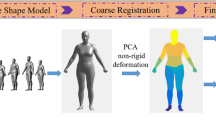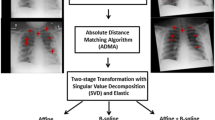Abstract
Purpose
In telemedicine such as remote auscultation, patients themselves or non-medical people such as patient’s parents need to place the stethoscope on their body surface in appropriate positions instead of the physicians. Meanwhile, as the position depends on the individual difference of body shape, there is a demand for the efficient navigation to place the medical equipment.
Methods
In this paper, we have proposed a non-rigid iterative closest point (ICP)-based registration method for localizing the auscultation area considering the individual difference of body surface. The proposed system provides the listening position by applying the body surface registration between the patient and reference model with the specified auscultation area. Our novelty is that selecting the utilized reference model similar to the patient body among several types of the prepared reference model increases the registration accuracy.
Results
Simulation results showed that the registration error increases due to deviations of the body shape between the targeted models and reference model. Experimental results demonstrated that the proposed non-rigid ICP registration is capable of estimating the auscultation area with average error 5–19 mm when selecting the most similar reference model. The statistical analysis showed high correlation between the registration accuracy and similarity of the utilized models.
Conclusion
The proposed non-rigid ICP registration is a promising new method that provides accurate auscultation area takes into account the individual difference of body shape. Our hypothesis that the registration accuracy depends on the similarity of both body surfaces is validated through simulation study and human trial.




Similar content being viewed by others
References
Zuhlke L, Myer L, Mayosi BM (2012) The promise of computer-assisted auscultation in screening for structural heart disease and clinical teaching: review article. Cardiovasc J Afr 23:405–408. https://doi.org/10.5830/CVJA-2012-007
Bennett JE, Stevens GA, Mathers CD, Bonita R, Rehm J, Kruk ME, Riley LM, Dain K, Kengne AP, Chikidou K, Beagley J, Kishore SP, Chen W, Saxena S, Bettcher DW, Grove JT, Beaglehole R, Ezzati M (2018) NCD countdown 2030: worldwide trends in non-communicable disease mortality and progress towards sustainable development goal target 3.4. The Lancet 392:1072–1088. https://doi.org/10.1016/S0140-6736(18)31992-5
Carvalho-Schneider C, Laurent E, Lemaignen A, Beaufils E, Bourbao-Tournois C, Laribi S, Flament T, Ferreira-Maldent N, Bruyere F, Stefic K, Gaudy-Graffin C, Grammatico-Guillon L, Bernard L (2021) Follow-up of adults with noncritical COVID-19 two months after symptom onset. Clin Microbiol Infect 27:258–263. https://doi.org/10.1016/j.cmi.2020.09.052
Raj V, Renjini A, Swapna MS, Sreejyothi S, Sankararaman S (2020) Nonlinear time series and principal component analyses: potential diagnostic tools for COVID-19 auscultation. Chaos Solitons Fractals 140:110246. https://doi.org/10.1016/j.chaos.2020.110246
Pereira D, Castro A, Gomes P, Areias JCNC, Reis ZSN, Coimbra MT, Cruz-Correia R (2016) Digital auscultation: challenges and perspectives. Encycl E-Health Telemed. https://doi.org/10.4018/978-1-4666-9978-6.ch070
Kim Y, Hyon YK, Lee S, Woo SD, Ha T, Chung C (2022) The coming era of a new auscultation system for analyzing respiratory sounds. BMC Pulm Med 22:1–11. https://doi.org/10.1186/s12890-022-01896-1
Grzywalski T, Piecuch M, Szajek M, Breborowicz A, Hafke-Dys H, Kocinski J, Pastusuak A, Belluzzo R (2019) Practical implementation of artificial intelligence algorithms in pulmonary auscultation examination. Eur J Pediatr 883:890. https://doi.org/10.1007/s00431-019-03363-2
Lv J, Dong B, Lei H, Shi G, Wang H, Zhu F, Wen C, Zhang Q, Fu L, Gu X, Yuan J, Guan Y, Xia Y, Zhao L, Chen H (2021) Artificial intelligence-assisted auscultation in detecting congenital heart disease. Eur Heart J Digital Health 2:119–124. https://doi.org/10.1093/ehjdh/ztaa017
Ishikawa T, Fujiwara K, Ohba H, Suzuki T, Ogasawara K (2017) Forecasting the regional distribution and sufficiency of physicians in Japan with a coupled system dynamics-geographic information system model. Hum Resour Health 15:1–9. https://doi.org/10.1186/s12960-017-0238-8
Voin V, Oskouian RJ, Loukas M, Tubbs RS (2017) Auscultation of the heart: the basics with anatomical correlation. Clin Anat 30:58–60. https://doi.org/10.1002/ca.22780
Chetverikov D, Svirko D, Stepanov D, Krsek P (2002) The trimmed iterative closest point algorithm. Proc Int Conf Pattern Recogn 16:545–548. https://doi.org/10.1109/icpr.2002.1047997
Bouaziz S, Tagliasacchi A, Pauly M (2013) Sparse iterative closest point. Eurogr Sympos Geom Process 32:113–123. https://doi.org/10.1111/cgf.12178
Deng B, Yao Y, Dyke RM, Zhang J (2022) A survey of non-rigid 3D registration. Preprint arXiv:2203.07858
Amberg B, Romdhani S, Vetter T (2007) Optimal step nonrigid ICP algorithms for surface registration. In: 2007 IEEE conference on computer vision and pattern recognition, pp 1–8. https://doi.org/10.1109/CVPR.2007.383165
Spinczyk D, Karwan A, Copik M (2014) Methods for abdominal respiratory motion tracking. Comput Aided Surg 19:34–47. https://doi.org/10.3109/10929088.2014.891657
Spinczyk D, Bas M (2019) Anisotropic non-rigid iterative closest point algorithm for respiratory motion abdominal surface matching. Biomed Eng Online 18:1–18. https://doi.org/10.1186/s12938-019-0643-4
Sayeed RA, Darling GE (2007) Surface anatomy and surface landmarks for thoracic surgery. Thorac Cardiovasc Surg 17:449–461. https://doi.org/10.1016/j.thorsurg.2006.12.002
Mochimaru M (2017) Digital human models for human-centered design. J Robot Mechatron 29:783–789. https://doi.org/10.20965/jrm.2017.p0783
Zhu Y, Smith A, Hauer K (2022) Automated heart and lung auscultation in robotic physical examinations. IEEE Robot Autom Lett 7:4204–4211
Sayeed RA, Darling GE (2007) Surface anatomy and surface landmarks for thoracic surgery. Thorac Surg Clin 17:449–461. https://doi.org/10.1016/j.thorsurg.2006.12.002
Alexiou E, Ebrahimi T (2020) Towards a point cloud structural similarity metric. In: 2020 IEEE international conference on multimedia and expo workshops (ICMEW), pp 1–6
Tsumura R, Koseki Y, Nitta N, Yoshinaka K (2023) Towards fully automated robotic platform for remote auscultation. Int J Med Robot Comput Assist Surg 19:e2461. https://doi.org/10.1002/rcs.2461
Kim R, Schloen J, Campbell N, Horton S, Zderic V, Efimov I, Lee D, Park CH (2021) Robot-assisted semi-autonomous ultrasound imaging with tactile sensing and convolutional neural-networks. IEEE Trans Med Robot Bionics 3:96–105. https://doi.org/10.1109/tmrb.2020.3047154
Tsumura R, Iwata H (2020) Robotic fetal ultrasonography platform with a passive scan mechanism. Int J Comput Assist Radiol Surg 15:1323–1333. https://doi.org/10.1007/s11548-020-02130-1
Acknowledgements
The research is supported by the JSPS KAKENHI Grant (Grant Number 21K20524) and JST FOREST Program (Grant Number JPMJFR215A).
Author information
Authors and Affiliations
Corresponding author
Ethics declarations
Conflict of interest
All authors declare no competing financial interests.
Ethical approval
The study protocol has been reviewed and approved by the institutional review board at National Institute of Advanced Industrial Science and Technology (No. 2022-1154). Informed consent was obtained from all individual participants included in the study.
Additional information
Publisher's Note
Springer Nature remains neutral with regard to jurisdictional claims in published maps and institutional affiliations.
Rights and permissions
Springer Nature or its licensor (e.g. a society or other partner) holds exclusive rights to this article under a publishing agreement with the author(s) or other rightsholder(s); author self-archiving of the accepted manuscript version of this article is solely governed by the terms of such publishing agreement and applicable law.
About this article
Cite this article
Tsumura, R., Morishima, Y., Koseki, Y. et al. Body surface registration considering individual differences with non-rigid iterative closest point. Int J CARS 18, 1511–1520 (2023). https://doi.org/10.1007/s11548-023-02842-0
Received:
Accepted:
Published:
Issue Date:
DOI: https://doi.org/10.1007/s11548-023-02842-0




